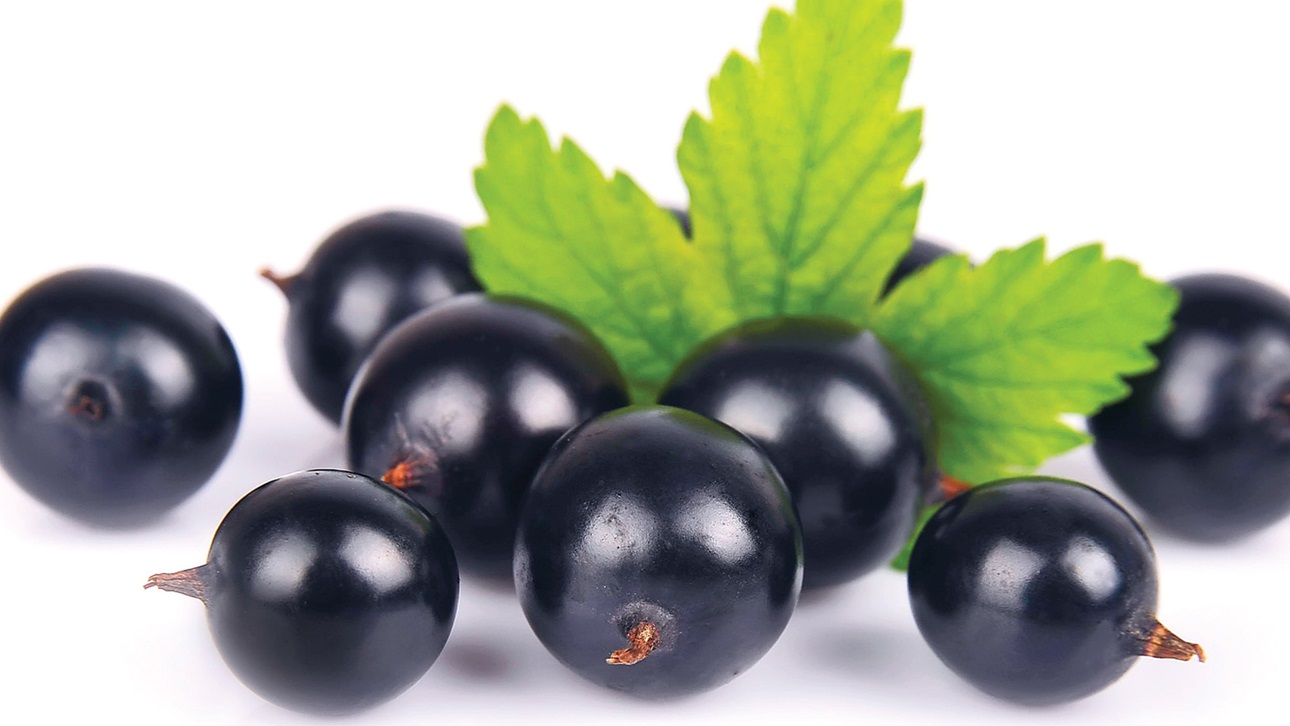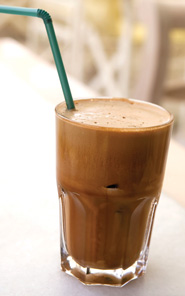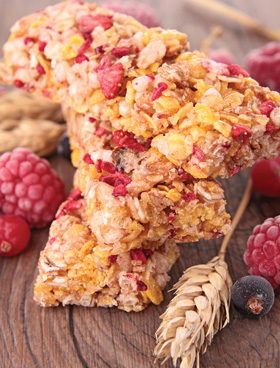The Buzz Around Energy
NUTRACEUTICALS
Whether it is for a quick pick-me-up, endurance throughout a workout, or just more energy over the course of the day, consumers look to functional beverages and snacks to provide extra fuel. The specific benefits consumers are looking for are energy throughout the day and energy in the morning to get started, according to data from the 2019 HealthFocus International Report, Global Energy Revolution. They also want more energy for exercise, a late-day boost, and between-meal maintenance.
The report states that physical and mental energy are the most important unresolved health conditions that foods and beverages can address: “These problems are not yet solved, and consumers need effective solutions. More demanding work requirements, household and family commitments, and exercising are creating increased opportunities to solve consumer energy needs.” Data from Global Energy Revolution also indicate that there is a need for energy across all demographic groups, with a concentration in women, the 18–29 age group, and households with children.
Mainstream companies have embraced consumers’ need for energy. For example, Starbucks’ ready-to-drink products include Refreshers with natural energy from green coffee extract, Doubleshot Espresso, which contains 145 mg of caffeine, and Tripleshot Energy with guarana, B vitamins, ginseng, and 225 mg of caffeine. Additionally, Coca-Cola this year launched Coca-Cola Energy made with guarana extracts and B vitamins in several European countries.
“The sought-after applications for energy-based products are still beverages, RTDs [ready-to-drink beverages], gels, and chews,” observes Marianne McDonagh, vice president of sales at Bioenergy. She adds that more unique energy applications include baked goods. In addition to wanting food and drink that boost energy levels throughout the day, consumers are also looking for trusted, familiar, and natural sources of energy.
B Vitamins, Carnitine, Taurine
In addition to caffeine, B vitamins, carnitine, and taurine are ingredients often used in energy drinks and snacks. B vitamins include thiamine (vitamin B1), riboflavin (vitamin B2), niacin (vitamin B3), pantothenic acid (vitamin B5), pyridoxine (vitamin B6), folate (vitamin B9), and cobalamin (vitamin B12). These are commonly used because they aid in the process of energy production in the body. Carnitine also plays a role in energy production by transporting long-chain fatty acids into the mitochondria where they are oxidized to produce energy. Taurine is an amino acid with antioxidant properties. It is often used in energy drinks because it has been reported to help reduce fatigue and improve exercise performance.
Botanicals
Guarana is one of the most popular botanicals used in energy products because it is considered a natural source of caffeine. Guarana seeds contain more than twice the amount of caffeine than coffee beans. Guarana also contains theophylline and theobromine, which are chemicals similar to caffeine.
Green coffee bean extract is another popular ingredient in energy products. In addition to containing caffeine, it contains chlorogenic acid, which is said to help with weight loss by promoting fat metabolism and inhibiting glucose absorption.
As the demand for natural sources of energy increases, other botanical sources have an opportunity for growth. One such botanical is Activeberry from Frutarom. It is an all-natural, black currant—derived ingredient for use in sports nutrition products for athletes and people with active lifestyles. Black currant contains anthocyanins, antioxidants, and other potent bioactive molecules. The ingredient is produced using a unique technology that maintains the properties of the berry without the use of solvents and other chemicals.
A recent study found that Activeberry, which was produced using this technology, had a more significant vasodilation efficacy than samples of black currant processed with the more common ethanol extraction method, according to Frutarom. Frutarom notes that the results of other research studies found that black currant had several health benefits, including increasing blood flow and antioxidative status, and improving aerobic performance.
Another company, Futureceuticals, offers two ingredients that function as natural sources of energy. The first ingredient, ElevATP, combines ancient peat extracts and apple polyphenols. It has been clinically shown to promote increased power output and training volume, support higher levels of mitochondrial adenosine triphosphate (ATP), and help improve athletic performance and body composition in resistance-trained athletes. ElevATP is unique in that it naturally helps the body produce its own ATP. Applications for ElevATP include energy bars and ready-to-mix/ready-to-drink beverages.
The other ingredient from Futureceuticals is Coffeeberry Energy, an organic and patented extract that contains caffeine and polyphenols from whole Arabica coffee cherries. It contains naturally occurring coffee polyphenols including chlorogenic acids, organic acids, and trigonelline.
Isomaltulose
“Demographics for food and beverage applications for energy run the gamut from active families to exercise fanatics and those who participate in endurance and extreme sports, as all types of consumers are seeking natural ingredients that provide healthful benefits,” says Jon Peters, president of BENEO Inc. “Consumers equate healthy living with an active lifestyle, which has led to a new trend called ‘sportification.’ Sportification is infused into many aspects of our lifestyles—from fashion to fitness gadgets as well as food and beverages that support healthy and active lifestyles containing ingredients from natural sources.”
BENEO’s Palatinose helps food manufacturers to develop products that meet these trends. Derived from sugar beet, Palatinose (isomaltulose) is a fully digestible disaccharide-type carbohydrate composed of glucose and fructose. As a result of its stronger linkage, it provides carbohydrate energy in a more steady and sustained way, with less effect on blood glucose levels and insulin. It creates an improved metabolic profile with more stable blood glucose levels and a higher contribution of fat utilization in energy metabolism. “The unique properties of Palatinose to promote higher fat-burning rates in energy metabolism have been shown in a large body of research including more than 10 human intervention studies,” says Peters.
König et al. (2016) showed that endurance athletes maintained a more stable blood glucose profile and higher fat oxidation, which resulted in improved cycling performance, when they preloaded with Palatinose compared with maltodextrin. The study used a randomized, double-blind cross-over design to compare the effects of Palatinose and maltodextrin on fuel flexibility, which is the switch between fat and carbohydrates as an energy source, and the subsequent effect on performance.
“Results gathered from the study highlighted that when the athletes consumed the drink containing Palatinose, they showed higher fat oxidation rates during the 90-minute endurance trial and performed better in the subsequent sprint test. On average, the athletes finished the time trial an entire minute faster with the drink containing Palatinose and were able to pedal more powerfully in the final five minutes of the time trial, compared to the maltodextrin control,” notes Peters. “The results also demonstrated that Palatinose stabilized the blood glucose profile, with a lower blood glucose rise before exercise, and maintained this level throughout endurance exercise. As a result, a higher fat-burning rate and lowered carbohydrate oxidation in energy metabolism were promoted. By improving fat oxidation during physical activity, Palatinose prolongs energy supply.”
A slow-release carbohydrate, Palatinose is digested in the small intestine rather than the stomach. This means it is digested more slowly and thus keeps blood sugar levels stable, explains Peters. “With a balanced blood sugar level, the body doesn’t pump out as much insulin. This combination of balanced blood sugars and moderated insulin levels allows the body to burn both carbohydrates and stored body fat, providing more sustained energy levels.” Palatinose is successfully utilized in healthy energy drinks like Kill Cliff Endure and the XE Lite beverage from Well Beyond, both of which support the Palatinose message of sustained energy through its low glycemic nature.
Ribose
“Energy beverage brands are considering more functional, unique ingredients that increase sustained energy the healthy way, as compared to the most common ingredients that can be harmful and not truly effective,” says Marianne McDonagh, vice president of sales at Bioenergy. “Specifically, consumers’ understanding of ATP and its precursors are evolving. Athletes frequently seek increased levels of ATP to produce sustained cellular energy for strength, power, and/or endurance. Increased ATP also helps nonathletic individuals adapt to physical activities or exercise.”
Bioenergy Ribose is a 5-carbon monosaccharide that regulates the body’s natural energy synthesis on a cellular level, helping to regenerate lost energy in muscles and reduce muscle soreness. The ingredient also supports weight management, cardiovascular health, and improves physical and athletic performance, according to the company. “The primary advantage of using Bioenergy Ribose in energy drinks and snacks is its unique ability to increase sustained energy and improve sports performance,” says McDonagh. “The natural process to replenish energy is very slow, especially in heart and muscle tissue. Bioenergy Ribose drives this ATP replenishment process, helping to achieve steady, sustainable energy levels.”
Fully soluble, high-heat stable, non-GMO, and GRAS Bioenergy Ribose has half the sweetness of table sugar, enabling the reduction of sugar in most formulas by about 10%, without worrying about aftertaste. “It is metabolized differently than table sugar, and does not affect the carb load, making it one of very few carbs that can be consumed by someone following a strict keto diet,” notes McDonagh.
Bioenergy in 2018 launched RiaGev, a combination of Bioenergy Ribose and a form of vitamin B3, distinctly formulated to enter the salvage pathway directly to more efficiently increase nicotinamide adenine dinucleotide (NAD) in the body. RiaGev maintains and enhances mitochondrial health by boosting NAD levels and inducing the creation of new mitochondria. Increased NAD and healthy mitochondria help slow the aging process, reduce age-related cognitive decline, prevent cellular damage from free radicals, create a stronger immune system, and contribute to lower cholesterol.
“Our idea was to develop a product that focuses on increasing both adenosine triphosphate (ATP) and nicotine adenine dinucleotide (NAD), while avoiding the pitfalls of other products seeking to do the same,” says McDonagh. “For NAD levels to be increased, [an] adequate amount of ATP must be available so why not use a product that increases both ATP and NAD at the same time?” As an ingredient, RiaGev is used in capsules and powders. Because it is easy to incorporate without affecting texture or taste, is not genetically modified, and is GRAS, it also has potential for use in functional foods and is suitable for clean label formulations.
Next month’s Nutraceuticals section will discuss ingredients derived from seafood.
REFERENCE
König, D., D. Zdzieblik, A. Holz, S. Theis, and A. Gollhofer. 2016. “Substrate Utilization and Cycling Performance Following Palatinose Ingestion: A Randomized, Double-Blind, Controlled Trial.” Nutrients. 8(7): 390.








